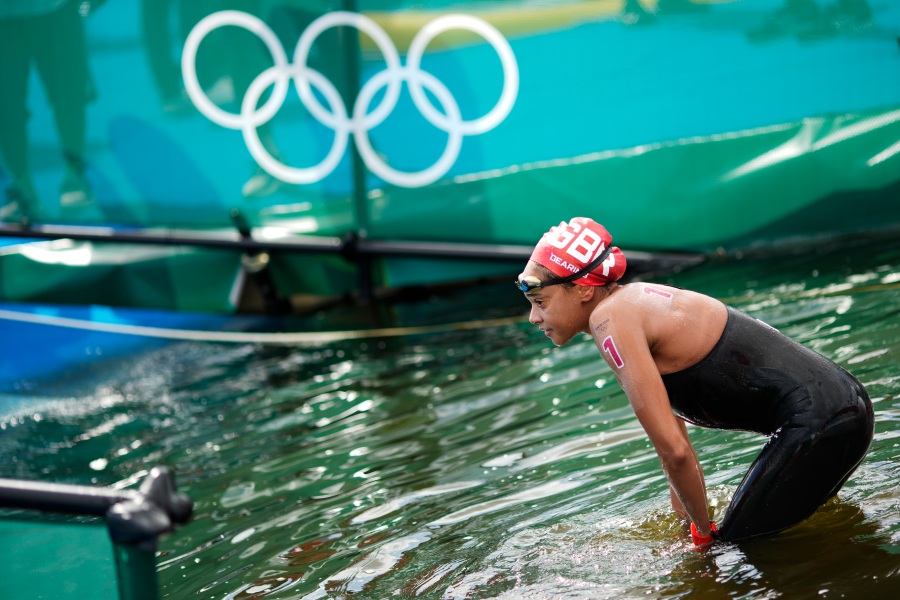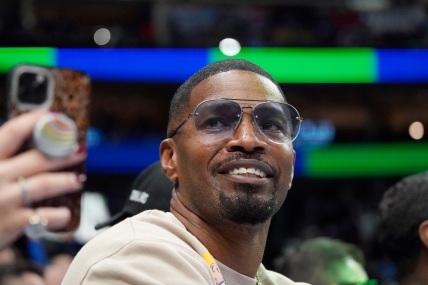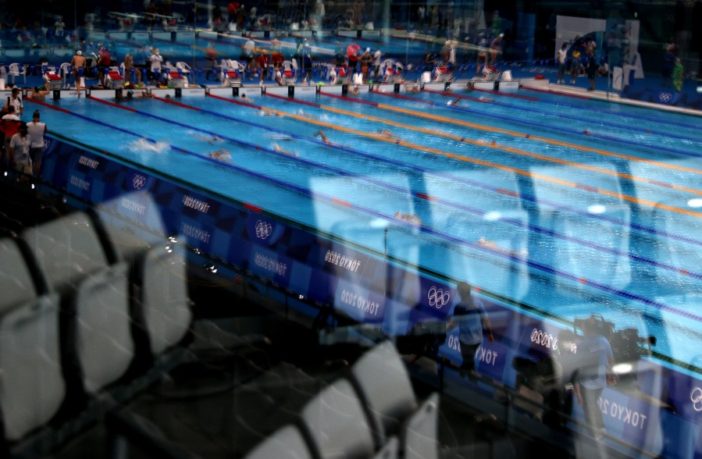The Soul Cap has gotten the green light from swimming’s top governing body, which figures to be a huge step toward bringing more diversity to a largely white sport.
You’ll have to look beyond the Olympics and world championships to spot its biggest impact.
The oversized, silicone cap, which is designed especially for Black swimmers with voluminous natural hair, already is making the pool deck feel more welcoming at the grassroots level.
TOKYO, JAPAN – JULY 28: A reflection of the pool seen against empty stands on day five of the Tokyo 2020 Olympic Games at Tokyo Aquatics Centre on July 28, 2021 in Tokyo, Japan. (Photo by Maddie Meyer/Getty Images)
The hope is that will lead to more swimmers of color reaching the sport’s highest echelons in the generations to come.
Seren Jones, co-founder of the British-based Black Swimming Association, is seeing signs of progress in her role as an instructor.
“I teach water safety to nonswimmers and beginners,” she said in a phone interview. “It’s absolutely incredible to see so many, really the majority of women across London, using the Soul Cap. I’m talking about women from the 20s to their 70s. It’s phenomenal. They feel empowered to learn and be safe in the water without worrying about their hair, which previously was a major issue.”

The Soul Cap initially was banned from competition by FINA, now known as World Aquatics, leading to harsh criticism during the Tokyo Olympics from supporters of more inclusive policies.
Most notably, open water competitor Alice Dearing — the first Black female swimmer to make the British team — thought FINA was out of touch for barring the Soul Cap on the grounds that it didn’t follow “the natural form of the head.”
Dearing had wanted to try the larger cap to cover her Afro.
Reversing course last September, the governing body added the Soul Cap to the list of approved equipment, with executive director Brent Nowicki saying “diversity and inclusivity is at the heart of FINA’s work.”
 FILE – Alice Dearing, of Britain, exits the water after finishing the women’s marathon swimming event at the 2020 Summer Olympics, Wednesday, Aug. 4, 2021, in Tokyo. The Soul Cap has gotten the green light from swimming’s top governing body, which figures to be a huge step toward bringing more diversity to a largely white sport. The oversized cap, which is designed to make it more comfortable for Black swimmers to hit the water with natural hair, will likely have its biggest influence at the grassroots level. That, in turn, could lead to more swimmers of color reaching the sport’s highest echelons in the generations to come.(AP Photo/David Goldman)
FILE – Alice Dearing, of Britain, exits the water after finishing the women’s marathon swimming event at the 2020 Summer Olympics, Wednesday, Aug. 4, 2021, in Tokyo. The Soul Cap has gotten the green light from swimming’s top governing body, which figures to be a huge step toward bringing more diversity to a largely white sport. The oversized cap, which is designed to make it more comfortable for Black swimmers to hit the water with natural hair, will likely have its biggest influence at the grassroots level. That, in turn, could lead to more swimmers of color reaching the sport’s highest echelons in the generations to come.(AP Photo/David Goldman)
Ashley Oakey, head of brand for Soul Cap, said the company’s product has filled a huge void in the sport by “appealing to individuals with thick, curly, or voluminous hair.”
“Traditional swimming caps often do not accommodate these hair types, hindering participation,” she said in an email Wednesday. “By providing a product specifically designed for such hair types, Soul Cap reduces this barrier, allowing more people to engage with the sport comfortably and competitively. This can help gradually diversify the swimmers’ demographic at all levels, from beginners to professionals.”
The world championships in Fukuoka, Japan, are the first major international meet since that ruling, but smaller caps that fit more snugly to the head remain the norm at the highest echelons of the sport. Top swimmers are focused on doing whatever they can to reduce drag, which leads to faster times.
“We have high hopes for the future,” Oakley said. “We anticipate that with growing recognition and acceptance, our caps will soon be a common sight at these prestigious events, thus promoting greater inclusivity in the sport of swimming.”

For now, Jones concedes, world-class athletes are not the Soul Cap’s target group.
“We all know that in swimming you want to be as streamlined as you can get,” Jones said. “That can make all the difference in a race that’s decided by thousandths of a second.”
At the lower levels, though, the Soul Cap can be a powerful conduit to reaching more swimmers of color.
“The large caps, the Soul Caps, are already making a massive difference in grassroots and recreational swimming,” Jones said. “It’s also making a difference for age-group swimmers. They get to dabble and experiment with serious training in a competitive environment. But the more serious a swimmer gets, you’ll probably see them resort back to the more traditional swim cap that exists now.”
Florida coach Anthony Nesty, who works with some of the biggest names in U.S. swimming, wasn’t even aware the Soul Cap had been approved for the world championships.
Yet, as the first Black man to win an Olympic swimming gold medal when he competed for Suriname at the 1988 Seoul Games, Nesty is eager to see a more diverse group of athletes on deck.
“Anything that can help the sport have more athletes of color is one less thing to worry about,” he said. “That will always be a plus.”
Cullen Jones, the groundbreaking Black American swimmer whose four Olympic medals include a pair of golds, is a big fan of the Soul Cap.
“One of the beautiful things about the Soul Cap model is the inclusivity for people with longer hair,” he said. “Men, women, people with longer hair can enjoy the water. I know that for a lot of the companies, many of the caps are made for hydrodynamics. The Soul Cap is more about being inclusive.”
Jones is still puzzled by FINA’s initial resistance to letting swimmers use the cap in competition.
“It’s not giving you any kind of edge,” he said. “But it’s giving people who might not have thought to do swimming the ability to feel comfortable around the water.”

That aligns with one of his passions: teaching more Black people how to swim. Coming from a family where many of his relatives have long hair, Jones said it’s important to have a cap “that makes them feel comfortable and not having to worry about hair, which is a big cultural thing — especially in the Black community, myself included.”
For Jones, this issue is especially poignant. He was diagnosed with alopecia near the end of his swimming career, causing him to lose all his hair.
“I had to go to a therapist to deal with a certain lack of identity because I didn’t have my hair,” he said. “I understand very much how important it is. So that barrier to entry is lifted with something like a cap that fits comfortably around your head.”
Bob Bowman, the Arizona State coach best known for his partnership with 23-time Olympic gold medalist Michael Phelps, does not know of any elite swimmers using the Soul Cap.
Even so, he believes it can a huge impact on the sport. He compared the Soul Cap to jammer swimsuits, which extend to just above the knee and made it far more appealing for young males to hit the pool a generation ago.
“I think that encouraged a lot of boys to swim since they didn’t have to wear a small Speedo,” Bowman said. “It’s the same kind of thing as that. It will encourage some people who might not have swum to try it.”
Seren Jones said the Soul Cap’s full impact will take years to realize.
She’s prepared to be patient.
“These things take time,” she said. “We still have a very long way to go. I’ve been on pool decks that look very much like they did when I was a swimmer 10 years ago. They are predominantly white. But there are more swimmers from different parts of the world taking this sport seriously.
“Let’s see how far they go.”
TheGrio is FREE on your TV via Apple TV, Amazon Fire, Roku, and Android TV. Please download theGrio mobile apps today!



